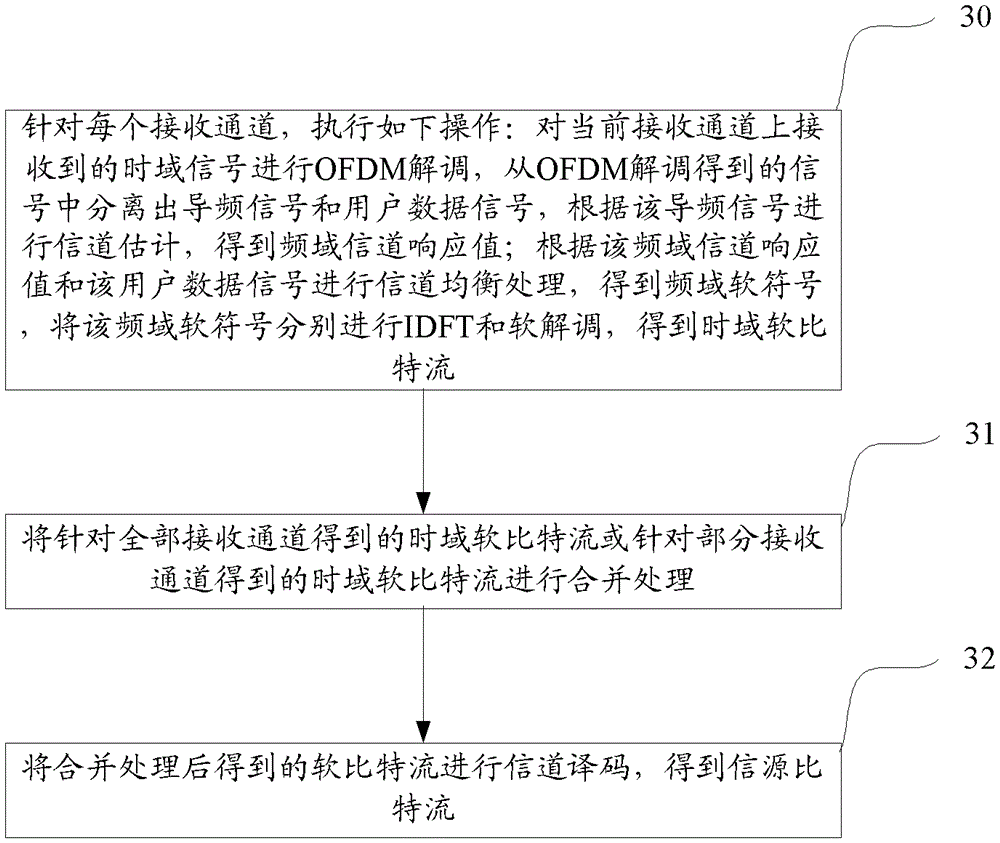Method and device for processing received signals
A technology for receiving signals and processing methods, which is applied to the shaping network in the transmitter/receiver, baseband system components, multi-frequency code systems, etc. Problems such as large number of problems, to reduce the processing complexity
- Summary
- Abstract
- Description
- Claims
- Application Information
AI Technical Summary
Problems solved by technology
Method used
Image
Examples
Embodiment 1
[0089]Step 1, start numbering from 0 for all receiving channels, record the total number of channels as N, and initialize the channel index n=0;
[0090] Step 2. On the receiving channel numbered n, perform the operations from step 2.1 to step 2.5 respectively:
[0091] Step 2.1, first perform operations such as removing cyclic prefix (CyclicPrefix, CP), OFDM demodulation, and removing 7.5KHz frequency offset on the received time domain signal;
[0092] Step 2.2, separate the pilot signal and user data signal from the signal obtained in step 2.1, use the pilot signal to perform channel estimation, and interpolate to obtain the user data signal r on the kth subcarrier n (k) Corresponding frequency domain channel response value H n (k);
[0093] Step 2.3, perform channel equalization processing according to the obtained frequency domain channel response value and user data signal, and obtain the frequency domain soft symbol s after channel equalization on the kth subcarrier n...
Embodiment 2
[0100] Such as Figure 3B As shown, without loss of generality, this embodiment assumes that the number of uplink transmit antennas of the UE is 1, that is, M=1; each RRU has only one receive antenna, which corresponds to one receive channel, and a BBU is connected to two antennas in total. RRU, that is, N=2.
[0101] Step 1, start numbering from 0 for all channels, record the total number of channels as N, and initialize the channel index n=0;
[0102] Step 2. On the receiving channel numbered n, perform the operations from step 2.1 to step 2.5 respectively:
[0103] Step 2.1, first perform operations such as de-CP, OFDM demodulation, and 7.5KHz frequency offset removal on the received time-domain signal;
[0104] Step 2.2, separate the pilot signal and user data signal from the signal obtained in step 2.1, use the pilot signal to perform channel estimation, and interpolate to obtain the user data signal r on the kth subcarrier n (k) Corresponding frequency domain channel ...
Embodiment 3
[0142] Step 1, start numbering from 0 for all receiving channels, record the total number of channels as N, and initialize the channel index n=0;
[0143] Step 2. On the receiving channel numbered n, perform the operations from step 2.1 to step 2.5 respectively:
[0144] Step 2.1, first perform operations such as removing the cyclic prefix (CP), OFDM demodulation, and removing the 7.5KHz frequency offset on the received time domain signal;
[0145] Step 2.2, separate the pilot signal and user data signal from the signal obtained in step 2.1, use the pilot signal to perform channel estimation, and interpolate to obtain the user data signal r on the kth subcarrier n (k) Corresponding frequency domain channel response value H n (k);
[0146] Step 2.3, perform channel equalization processing according to the obtained frequency domain channel response value and user data signal, and obtain the frequency domain soft symbol s after channel equalization on the kth subcarrier n ;
...
PUM
 Login to View More
Login to View More Abstract
Description
Claims
Application Information
 Login to View More
Login to View More - R&D
- Intellectual Property
- Life Sciences
- Materials
- Tech Scout
- Unparalleled Data Quality
- Higher Quality Content
- 60% Fewer Hallucinations
Browse by: Latest US Patents, China's latest patents, Technical Efficacy Thesaurus, Application Domain, Technology Topic, Popular Technical Reports.
© 2025 PatSnap. All rights reserved.Legal|Privacy policy|Modern Slavery Act Transparency Statement|Sitemap|About US| Contact US: help@patsnap.com



